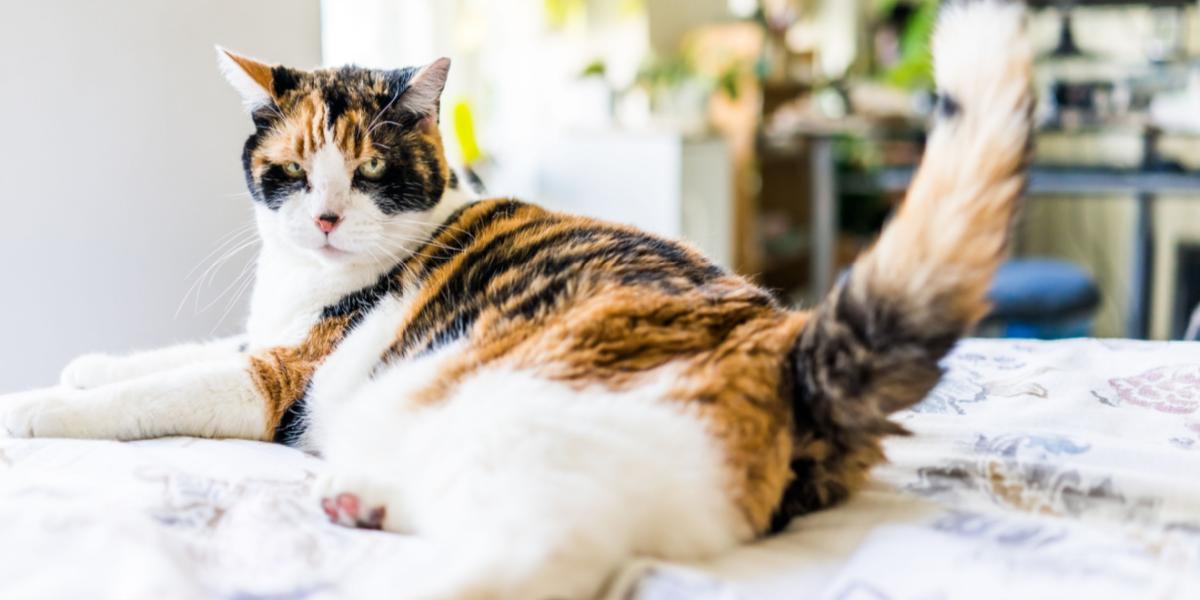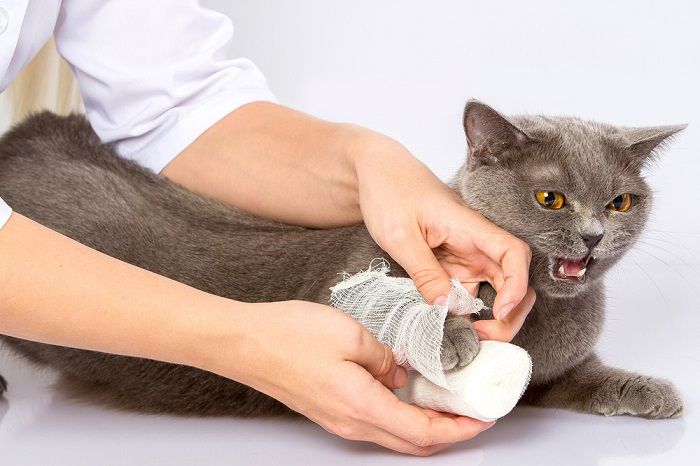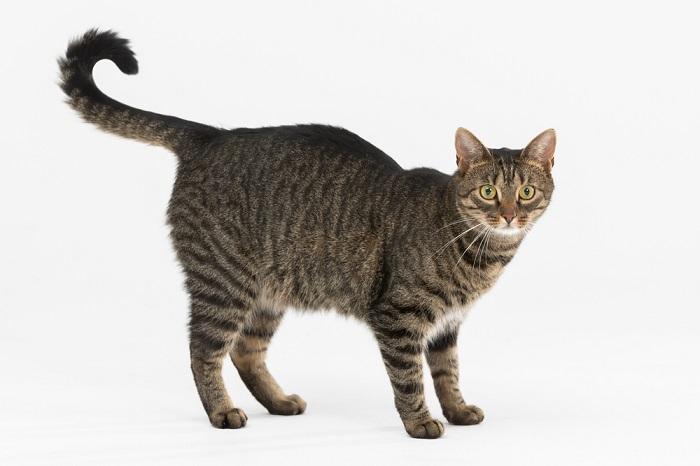
Have you ever seen cats wag their tails and wondered why? Perhaps you thought cats only wag their tails back and forth when they are angry or annoyed, but you’ve noticed your cat does it in many different situations.
In this article, we will consider the different ways that cats use their tail to communicate and what the position of their tail may mean, according to feline body language.
Cats wag their tails sometimes for a variety of reasons. Cats use their tails to communicate how they are feeling. Learning your cat's body language cues is one of the best ways to create a strong bond and harmonious life with your cat.Key Takeaways
The Importance of Cat Body Language
Cats are highly complex creatures, and our understanding of their behavior is incomplete. This is improving, thanks to dedicated behaviorists and veterinarians actively researching cat behavior. Just remember that cats are not tiny humans, and their behavior is very different from ours.
Assuming your cat will enjoy something, just because you do, or not understanding what your cat is trying to tell you, will only lead to frustration or fear developing in your cat. In the long term, this leads to severe behavioral issues that can be very hard to correct.
Cat tail language is just one way of communication. Learning about cat behavior and allowing your cat’s cues to guide your interactions with them is a wonderful way to help your cat feel comfortable and at ease with you. This leads to a more fulfilling relationship between the cat and the cat owner, as it is mutually beneficial, creating a more harmonious life together.
Also Read: 5 Easy Tricks to Teach Your Cat According to a Cat Behaviorist
Why Does My Cat Wag Their Tail?
If your cat is wagging their tail, it can mean many different things. It is essential to consider your cat’s situation, how your cat is wagging their tail, and what they are doing with the rest of their body to best interpret the behavior. Below are a few examples of what your cat might be feeling once the tail starts wagging.
1. Your Cat is Unhappy
When a cat is unhappy or angry, they may hold their tail low and flick it quickly back and forth. This behavior is often seen when a cat is in a situation they aren’t pleased with. In this instance, it is best to give the cat some space. An angry cat can quickly become aggressive if they feel their boundaries are not being respected.
2. Your Cat is Annoyed
When annoyed, cats will move their tail in a slow swish, moving back and forth. Sometimes they may just twitch the end of their tail like a rattlesnake rattling its tail. If you see this, give your cat some space before they become angry or aggressive.
3. Your Cat is Frustrated
When frustrated, a cat will thrash their tail in all directions. Frustration is commonly seen in caged cats or those that can see another cat in their territory (such as the garden or lawn) but can’t get to them.
4. Your Cat is in Pain

Cats that are in pain might bite, even if they are usually very docile.
Some cats will wag or flick their tails as a sign of pain or discomfort. You may notice this more when your cat is lying down. It is often accompanied by other signs of feeling unwell at home, such as reduced appetite, increased or decreased thirst, or hiding away more than usual.
If you think your cat is wagging their tail because something is wrong, contact your veterinary clinic to arrange a consultation as soon as possible. If you’re unsure if there’s a problem, have a chat with your vet to plan the best course of action.
5. Your Cat is Happy
A happy cat will usually approach you with their tail straight up or in an upright “question mark” shape. Some cats wag their tails when they are happy; an example would be a friendly tail quiver as your cat greets you.
6. Your Cat is Scared
A frightened cat may hold their tail low and wag it back and forth. They may also hide their tail by tucking it away or puffing up their fur. Other signs of fear include pinning back the ears, a low crouch, or vocalization such as hissing or growling.
7. Your Cat is Excited
A very excited cat commonly twitches their tail. This behavior is often accompanied by teeth chattering or chirping and is commonly seen when a cat views a prey animal through a window. This behavior can, however, also reflect frustration that they cannot get to the prey creature.
If a cat is simply concentrating intently on the prey, they may also move their tail in short, quick twitches, which is common in playful cats, too.
Also Read: Why Do Cats Chase Their Tails?
8. Your Cat is Dreaming
Cats that twitch their tail during a nap may be doing so as a sign of contentment or they are dreaming.
What Other Things Does Your Cat’s Tail Tell You?
Cats use their tail to communicate a wide variety of things. Here are some other cat tail signs that are helpful to understand.
1. Straight, Upright Tail
Generally, a high, straight tail is a friendly sign of greeting in cats. I affectionately term it “happy tail” when my cats welcome me like this.
2. Question Mark Tail
If your cat’s tail resembles a question mark when they greet you, this is another friendly communication gesture.
3. Puffed-Up Tail
If all the fur on your cat’s tail is puffed up, this is usually a sign that they feel threatened. By fluffing up the tail, they look bigger and scarier, which sends the message of “don’t mess with me.” It is often accompanied by a hiss. Cats showing this body language are teetering on the edge of aggression, so do not startle them or attempt to handle them in this state.
4. Low Tail
A cat holding their tail low to their body reflects anxiety, fear, or stress.
5. Tucked Tail
If your cat is tucking their tail tightly under their body, they are likely frightened or anxious about their current situation.
6. Tail Hug
When your cat wraps their tail around you while rubbing against your legs, they are showing you that they love you. A wrapping tail is a sign of affection between socially bonded cats.
7. Floppy Tail
If your cat has a floppy tail that is hanging limply, this can be a sign of an injury. In cats, this is often a tail pull injury, where the tail has been pulled back from the body. It can happen for many reasons, but severe cases lead to permanent nerve damage, requiring tail amputation.
Sometimes the nerves affecting the bowel and bladder can be affected too. If you notice your cat’s tail is limp or floppy, your cat should be seen urgently by your local veterinarian.
Also Read: 10 Reasons Why Cats Put Toys In Food Or Water Bowls
Final Thoughts

To decode why your cat is wagging their tail, take a look at some of their other body language.
Can you believe that one tail can tell you so many different things about your cat’s emotions? Remember that every cat is different, and some will be more expressive than others when it comes to tail communication.
You know your cat better than anyone, so take their tail cues in the context of the situation and their mood to best understand how your cat is trying to communicate with you. Taking care to understand your cat’s body language will strengthen the bond you share, and give you both a satisfying relationship.
Also Read: How to Have a Better Relationship With Your Cat
Frequently Asked Questions
Why do cats wag their tails while lying down?
Your cat's tail communicates a whole host of different emotions. When your cat is lying down and wagging their tail, it may mean they are content, but it also can mean they are stressed, worried, frightened, frustrated, or even in pain.
It is essential to look at your cat's entire body language and the environment around them to work out what they are feeling. It is vital to consider if your cat has been showing any signs of illness at home, such as reduced appetite, drinking more than usual, or hiding away.
If this is the case, your cat's tail wagging while lying down may mean there is a problem, and you should arrange a trip to your veterinary clinic as soon as possible.
Are cats happy when they wag their tails?
Unlike dogs, a wagging cat tail is usually not a sign of happiness, although some cats will wag their tails when they are feeling content.
Do cats wag their tails when mad?
Yes. Depending on other body language cues and the context of the situation, a cat wagging their tail can signify anger.
Why do cats wag their tails when they are being pet?
When you are petting your cat, you may notice them start to wag their tail. Usually, this will be a flick or twitch, but sometime the whole tail may wag too. Cats do this while being petted for several reasons, including feeling content and secure but also feeling frustrated or annoyed.
If your cat is purring and maybe kneading you, then they are likely content. Keep an eye out for shifts in body language, as cats can quickly decide they are done with petting and will sometime bite or scratch. Relying on a tail wag alone may not give you adequate warning that your cat doesn't want to be pet anymore!
-
Ellis. S (2018) Recongnising and assessing feline emotions during the consultation: History, body language and behaviour. Journal of Feline Medicine and Surgery. DOI https://doi.org/10.1177/1098612X18771206 Retrieved July 18th 2022
-
Horwitz. D and Rodan. I (2018) Behavioral awareness in the feline consultation: Understanding physical and emotional health. Journal of Feline Medicine and Surgery. DOI https://doi.org/10.1177/1098612X18771204 Retrieved July 18th 2022
-
Merola. I and Mills. D (2015) Systematic review of the behavioural assessment of pain in cats. Journal of Feline Medicine and Surgery. DOI: https://doi.org/10.1177/1098612X15578725 Retrieved July 18th 2022.







